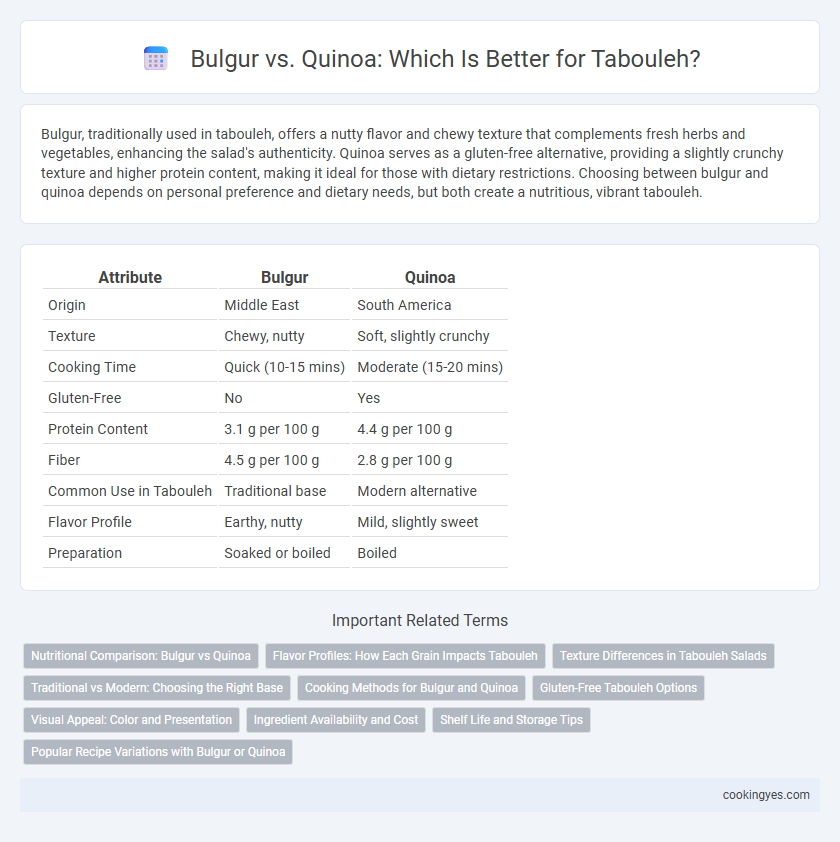Bulgur, traditionally used in tabouleh, offers a nutty flavor and chewy texture that complements fresh herbs and vegetables, enhancing the salad's authenticity. Quinoa serves as a gluten-free alternative, providing a slightly crunchy texture and higher protein content, making it ideal for those with dietary restrictions. Choosing between bulgur and quinoa depends on personal preference and dietary needs, but both create a nutritious, vibrant tabouleh.
Table of Comparison
| Attribute | Bulgur | Quinoa |
|---|---|---|
| Origin | Middle East | South America |
| Texture | Chewy, nutty | Soft, slightly crunchy |
| Cooking Time | Quick (10-15 mins) | Moderate (15-20 mins) |
| Gluten-Free | No | Yes |
| Protein Content | 3.1 g per 100 g | 4.4 g per 100 g |
| Fiber | 4.5 g per 100 g | 2.8 g per 100 g |
| Common Use in Tabouleh | Traditional base | Modern alternative |
| Flavor Profile | Earthy, nutty | Mild, slightly sweet |
| Preparation | Soaked or boiled | Boiled |
Nutritional Comparison: Bulgur vs Quinoa
Bulgur contains approximately 76 calories and 3.1 grams of protein per 100 grams, offering high fiber content essential for digestion, while quinoa provides around 120 calories and 4.1 grams of complete protein per 100 grams, including all nine essential amino acids. Quinoa delivers a richer profile of vitamins such as B-complex vitamins and minerals like magnesium, iron, and zinc, making it nutritionally superior for a balanced diet. Bulgur has a lower glycemic index, beneficial for blood sugar control, whereas quinoa's gluten-free nature suits those with gluten sensitivities in traditional tabouleh recipes.
Flavor Profiles: How Each Grain Impacts Tabouleh
Bulgur offers a nutty and slightly chewy texture that complements the fresh herbs and tangy lemon juice in traditional tabouleh, enhancing its authenticity. Quinoa provides a lighter, fluffier texture with a subtle earthiness that adds a unique twist while maintaining a refreshing balance. The choice between bulgur and quinoa significantly influences the overall flavor profile, with bulgur delivering a heartier base and quinoa contributing a more delicate, mild taste.
Texture Differences in Tabouleh Salads
Bulgur in tabouleh offers a chewy, nutty texture that complements the salad's fresh herbs and vegetables, providing a slightly grainy mouthfeel that holds dressing well. Quinoa delivers a fluffier, softer texture with a subtle crunch from its tiny seeds, creating a lighter, more delicate salad experience. The choice between bulgur and quinoa significantly influences tabouleh's overall texture, balancing chewiness versus tenderness to suit different dietary preferences and textures.
Traditional vs Modern: Choosing the Right Base
Bulgur is the traditional base for tabouleh, offering a nutty flavor and chewy texture that complements the fresh herbs and vegetables characteristic of this Levantine salad. Quinoa provides a gluten-free, protein-rich alternative favored in modern adaptations, enhancing the nutritional profile while maintaining a similar grainy consistency. Choosing between bulgur and quinoa depends on dietary needs and desired authenticity, with bulgur preserving classic taste and quinoa catering to contemporary health trends.
Cooking Methods for Bulgur and Quinoa
Bulgur for tabouleh is traditionally prepared by soaking it in cold water or briefly boiling until tender, allowing it to retain a chewy texture while absorbing flavors. Quinoa requires rinsing to remove saponins before boiling in water for about 15 minutes, resulting in a fluffier and slightly nuttier grain. Both grains absorb the fresh lemon juice and olive oil dressing well, but bulgur maintains a more authentic tabouleh texture compared to the lighter quinoa.
Gluten-Free Tabouleh Options
Quinoa serves as an excellent gluten-free alternative to bulgur in tabouleh, maintaining the dish's traditional texture while catering to gluten-sensitive individuals. Bulgur, a wheat product, contains gluten, making it unsuitable for those with celiac disease or gluten intolerance. Using quinoa enhances the nutritional profile of tabouleh by adding complete protein and essential amino acids, ensuring a healthier, allergen-friendly option without compromising flavor.
Visual Appeal: Color and Presentation
Bulgur offers a warm golden hue that contrasts beautifully with the vibrant green parsley and red tomatoes in tabouleh, enhancing visual appeal through traditional colors. Quinoa, available in white, red, and black varieties, adds a unique speckled texture and diverse color palette, making the salad visually intriguing and modern. Choosing between bulgur and quinoa impacts presentation by either preserving classic aesthetics or introducing contemporary, colorful elements to tabouleh.
Ingredient Availability and Cost
Bulgur remains the traditional and more cost-effective choice for tabouleh, widely available in Middle Eastern grocery stores and supermarkets. Quinoa offers a gluten-free alternative but tends to be pricier and less accessible in some regions. Both grains provide nutritional benefits, yet bulgur's affordability and availability make it preferred for authentic tabouleh preparation.
Shelf Life and Storage Tips
Bulgur has a shelf life of up to 1 year when stored in a cool, dry place in an airtight container, making it a reliable grain for long-term storage in tabouleh preparation. Quinoa, while slightly shorter-lived at around 6 to 8 months under similar conditions, requires refrigeration after opening to maintain freshness and prevent spoilage. Proper storage of both grains, away from moisture and direct sunlight, ensures optimal texture and flavor retention in tabouleh dishes.
Popular Recipe Variations with Bulgur or Quinoa
Tabouleh traditionally features bulgur, a cracked wheat that provides a nutty texture and absorbs lemon and herb flavors well, making it a staple in Middle Eastern cuisine. In popular recipe variations, quinoa is used as a gluten-free alternative, offering a higher protein content and a slightly earthier taste while maintaining the salad's fresh, herbaceous profile. Both bulgur and quinoa pairs seamlessly with parsley, mint, tomatoes, and lemon juice, catering to diverse dietary preferences without compromising the classic tabouleh flavor.
Bulgur vs Quinoa for Tabouleh Infographic

 cookingyes.com
cookingyes.com